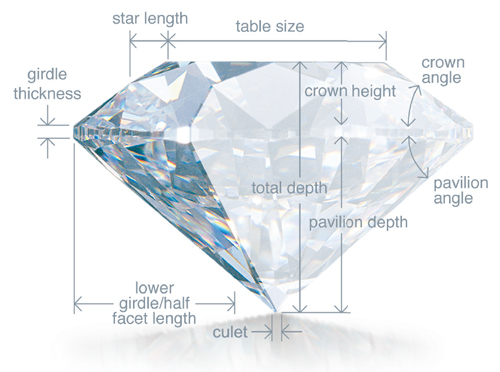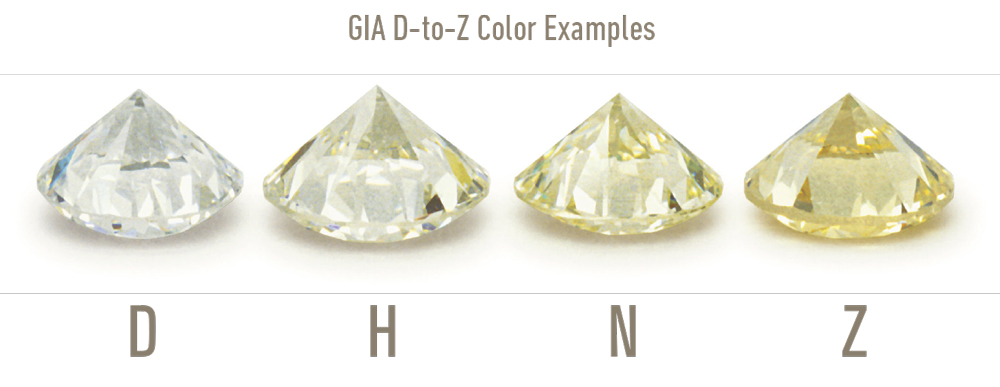

 The Four Cs
The Four CsAt Diamond and Gold Warehouse our diamond and jewelry education will help you to make informed and confident decisions with your diamond and fine jewelry purchases. We specialize in Wholesale GIA Certified Diamonds and Engagement Rings. The 4Cs of a diamond is the universal way of communicating a diamond’s quality characteristics. Understanding these 4 main components help you express a diamond’s value. The 4 Cs are--Cut, Carat Weight, Clarity, and Color. Let’s look at each one separately.
Cut refers to the quality of the cutting and polishing done on a diamond. Using expertise, a skilled diamond cutter transforms rough diamonds into polished ones--releasing the stone’s highest potential to handle light. Nature determines so much about a diamond, yet it takes a master cutter to reveal the stone’s internal brilliance, fire, and scintillation.
Facet patterns which contribute to a diamond’s brilliance are the result of scientific formulas, which were perfected over the centuries. Well-cut diamonds reflect light from its interior through mirror-like facets so that it can disperse sparkling brilliance. Symmetry, balance, and fine polish are the objectives in reaching a well-cut stone. A diamond that is cut too shallow or too deep will have a negative impact on that diamond’s light performance.

Size is an important contributor in determining the value of a diamond. Often the bigger the diamond, the higher the price tag. That’s because larger carat size diamonds are rarer. However, two diamonds of equal size can still have different values, since the value is determined by the overall quality of the stone.
Clarity is a characteristic of the diamond’s lack of, or number of internal and/or external flaws.
These flaws are called inclusions. The fewer flaws or inclusions, the greater the stone will handle light and sparkle. Abundant dark-colored inclusions will make the stone less brilliant. Any disruption to the light performance inside the diamond from an inclusion will lessen its sparkle, and as a result, its brilliance could be diminished.

FL-Flawless, IF-Internally Flawless, VVS-Very Very Slightly Included, VS-Very Slightly Included, SI-Slightly Included, I-Included. Within some of the categories--there is a division, such as VVS1 and VVS2 to further describe the clarity grade.
Inclusions are sometimes referred to as “Nature’s Fingerprints.” Unless magnified, inclusions may not always be visible to the unaided eye.
The position and size of the inclusion(s) affect the diamond’s clarity grade. Since there are very few flawless diamonds found in nature, completely flawless diamonds are extremely valuable. The location of inclusions are important too. An inclusion in the middle or top of a diamond (viewed face up) could impact the dispersion of light, rendering the diamond less brilliant and less desirable.
To view inclusions, jewelers use a magnifying loupe at 10X or a jewelers microscope. These tools allow jewelers to see the internal characteristics of the stone. Even with a loupe, inclusions in the VVS (Very Very Slightly Included) to VS (Very Slight Included) range can be very difficult to find. Some inclusions can be hidden by a mounting, thus having little effect on its beauty.
Diamonds are valued for their lack of color.

A totally colorless diamond acts as the best prism for light to pass through effortlessly, displaying its magnificent brilliance. Since truly colorless stones are rare in nature, they are the most desirable and valuable.

The diamond color grading scale was also established by the leading authority, GIA (Gemological Institute of America). The color grading scale begins with D for totally colorless and ends at Z for yellow stones. The differences between one grade and another may be quite subtle but have a considerable impact on its pricing and value. Colors are graded under specifically controlled lighting conditions so that the color grading is reliable. The stones are then compared to a master set for accuracy.
Besides colorless diamonds, they are also naturally produced in a rainbow of hues like blue, green, yellow, black, orange, brown, pink or the rarest of them all, red. These diamonds are referred to as fancy colored diamonds and are extremely rare and highly desired.
On an engagement ring, the head is the portion of metal which holds the center stone. The head is made up of prongs, which secure the center stone in place.
The mounting or setting refers to the entire ring without the center stone.
A semi-mount refers to a ring which is set with small pave diamonds, without the center stone.
The basket is a type of head which has a low profile. Basket heads are typically used for earrings and large gemstones which need to sit close to the skin.
The shank is simply the ring band. There are a variety of shank styles available such as split shank, tapered shank, or knife-edge shank, to name a few.
The cathedral is a mount which rises up from the side stones, similar to an arch, reaching the same level as the center stone edge. This is known as one of the most classic and elegant engagement ring settings.
In a shared prong setting, rounded pieces of metal sit between each stone, securing them in place. Each stone shares a set of prongs. This setting is commonly used in most engagement rings and wedding bands, as they are very secure.
In a channel setting, each gemstone or diamond are set next to each other. This setting does not have prongs. Instead, two metal bars hold the diamonds in place. This setting provides ultimate sparkle without the interruption of prongs.
In a french set is a type of shared prong setting. The small diamonds sit very close together, giving the ring ultimate sparkle.